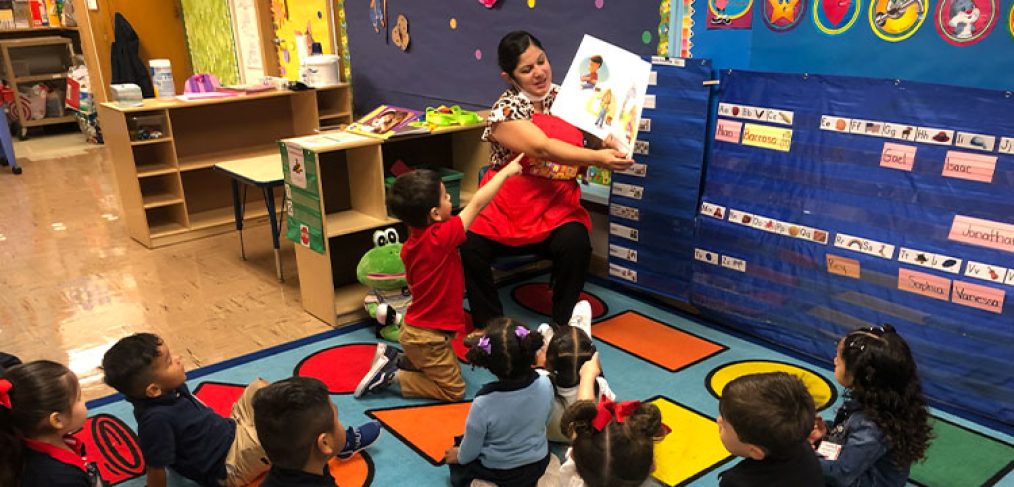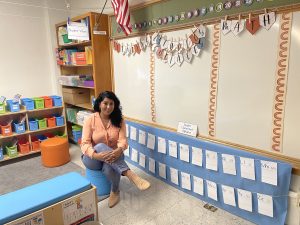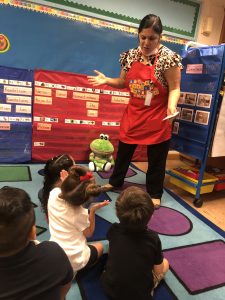
Central staff go back to the classroom
Evelyn Lopez and Patricia Barroso were well into planning out their year as early learning specialists when the call came last week for Teaching and Learning staff to support students in a more direct way—as teachers of record in schools across the district.

Evelyn Lopez set up her classroom with the help of her Early Learning colleagues.
“My first reaction was surprise,” said Evelyn Lopez, who is teaching first grade at John W. Carpenter Elementary School. “But when Chief [Shannon] Trejo shared the reality that some kids would not have a teacher on their first day, I knew that’s what I had to do. My mind immediately transitioned to being back in the classroom.”
“My son started first grade this year, and I imagined how he would feel if he didn’t have a teacher there to provide a welcoming environment and be there for him,” she added. “Sometimes, the bravest thing you can do is show up and be present and ready to work for the kids.”
Dallas ISD was facing starting the new school year with some classrooms without a teacher due in great part to a national teacher shortage, so central divisions stepped up to send certified staff back to the classroom to serve as teachers of record in bilingual, special education and core content classrooms. While the district still has teacher vacancies it is working to fill with new hires, the central staff deployment meant that students in almost 100 classrooms had a certified teacher of record welcoming them to their first day of class.
“We are focusing on the vision to put kids first,” Trejo said. “We value our campus teachers and now have a system in place to support them in a different way.”
The Teaching and Learning Division has identified 145 certified staff who can be deployed to campuses—especially high priority and ACE schools—to fill vacancies and other classes that need additional supports through at least Sept. 23 when campus needs will be re-evaluated based on student enrollment, the fall leveling process and hiring capacity, said Trejo. Our team is ready and willing to serve as teacher of record until the end of year to ensure that students have the best learning experience possible. If a full-time teacher is identified for that position before Sept. 23, the central staff member would remain on the campus to help with the transition, content training, and acclimation to the classroom systems that have been established before returning to prior duties.

Patricia Barroso
Barroso—who was a teacher for 14 years before becoming an early learning specialist six years ago—immediately switched to teacher mode when she heard she was going back to the classroom. Like Lopez, her first priority was to set up the classroom to welcome students.
The Saturday before school started, she spent several hours preparing her pre-K 3 classroom at Edwin J. Kiest Elementary School with the help of other early learning staff.
“I thought, ‘I have done this before and I am going to give it my all like all other teachers.’ There is no room for questions or wondering why,” Barroso said. “You show up for the kids. At that age, they need to have a good first day, a good first impression of their first day of school that will set the foundation for every other year.”
Transitioning back into the classrooms has had its challenges and adjustments, but Barroso and Lopez agree that putting kids first means being flexible and willing to go where they are needed for as long as they are needed.
“When the call comes, it’s all hands on deck,” Lopez said.
The goal will be to continue to recruit high quality teachers into the district during the fall semester. Potential candidates such as December college graduates or teachers qualifying under alternative certification will be a pipeline for placements in January. The team will remain committed to maintaining and/or reassigning central office staff to classrooms that remain unfilled at that time.



